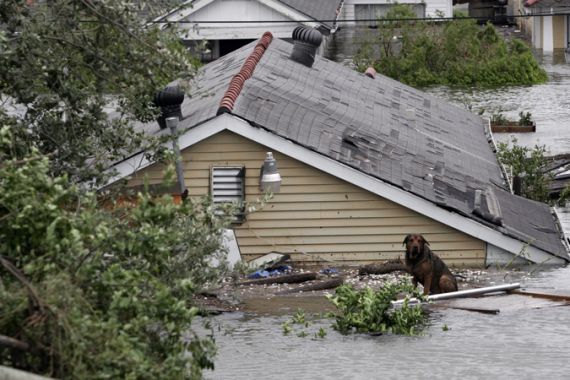Hurricane season reveals economic perils of ignoring climate predictions
Warming surface waters are increasing tropical cyclone intensity, so why are we being so irresponsible?

The correlation between warming surface waters and tropical cyclone intensity has been scientifically verified. While it’s unclear if climate change is causing an uptick in natural disasters, we cannot deny that the percentage of Category 4 and 5 hurricanes has increased since the 1980s. In that same period, sea levels have risen and by some estimates, they have been since 1880. Human activities such as burning fossil fuels and clearing forests release excessive carbon dioxide and other heat-trapping gases into the atmosphere, and incontrovertible evidence shows that in the past 50 years, over 90 per cent of this warming has gone into our oceans. In spite of the facts, however, a stormy debate over correlation and causation rages every hurricane season, and this year’s hurricane season is no different. This debate distracts us from another inconvenient truth: underestimating climate change poses an economic threat, particularly to coastal communities.
Living in the path of a hurricane is a financially risky business. The number of US weather disasters totaling at least $1 billion in damages doubled in the past 15 years, totaling 87 disasters up from 46 disasters in the previous 1980 to 1995 period. Hurricanes Rita and Katrina alone caused $165 billion in combined damages. “Whether it’s the ‘new normal’ or not, the industry sees a pattern of losses that’s extraordinary,” said Frank Nutter of the Reinsurance Association of America, quoted in this month’s National Geographic cover feature “Weather Gone Wild“.
Insurance market specialist Lloyd’s reports that “despite widespread concerns about the affordability and availability of property insurance in coastal areas, few people are currently considering how the insurability of their homes and businesses might be affected by increases in risk due to climate change”. Without adaptation to the new climatic reality, insurance losses from coastal flooding for high-risk properties could double by 2030.
| Inside Story Americas – Extreme weather: Linked to climate change? |
But it’s not the insurance companies who suffer most of those losses, it’s homeowners and business owners. Already, State Farm has proposed to deny renewal of coverage on more than 11,000 Gulf Coast home insurance policies. In Florida, State Farm even tried to cash in on the crisis. After announcing that expenses from hurricanes were forcing it to drop nearly half a million customers, State Farm invested in DaVinci, an unregulated offshore reinsurance venture that would offer coastal residential policies, but at exorbitant prices. (In fact, State Farm and its Bermuda partner, RenaissanceRe, created DaVinci within weeks of the 9/11 attacks to capitalise on price increases that followed the disaster.)
As national firms back off from insuring residents in high-risk areas, small companies have appeared to fill the gap. In Florida, the state government also created the Citizens Property Insurance Corporation, the “insurer of last resort“, for homeowners who can’t find coverage in the voluntary market. And, as in 16 other hurricane-prone states, lawmakers passed legislation requiring carriers to impose percentage hurricane deductibles based on the home’s insured value, thus requiring Florida’s policyholders to share in the risk of loss. We don’t yet know how well these financial solutions will withstand the next great hurricane.
Our collective failure to take seriously the effects of climate change – coupled with private industry’s reticence to cover the costs of coastal disaster cleanup – should make Americans think twice about slashing disaster relief budgets. Yet, House Republicans held disaster relief funding hostage several times in the past two years.
In 2011, although House GOP members did approve $1 billion in supplemental relief for the Missouri tornado, they insisted on financing the disaster aid package through a $1.5 billion cut from a loan programme to encourage the production of fuel-efficient vehicles. This was an ironic trade-off, as greater fuel efficiency would in part help mitigate climate change by reducing carbon emissions.
Humans have failed to prepare for climate crises since the time of Noah, but Noah didn’t have the overwhelming consensus of climate scientists that we have today. As coastal communities from San Francisco Bay to Miami-Dade County brace themselves for climate change, many others are delaying the inevitable and may soon be scrambling to adapt to the consequences. As climate change imperils coastal economies, more of us may be affected than we realise. Nearly 9 million Americans live less than one metre above the high-tide line, and over half of America’s population live within 50 miles of the coast.
We can’t expect to bury our heads in the sand and avoid loss of property and life. As Mayor Bloomberg of New York City said, “We face two urgent challenges. First, we have to shrink our carbon footprint to slow climate change. Second, we have to adapt to the environmental challenges that are already beginning to take place.” Last week, New York City Council unanimously passed legislation – the first to be enacted by any state or local government in the US – to make climate change mitigation and adaptation central to its city’s planning.
Much more leadership, creative thinking, and cooperation must flow, and quickly. To disregard the research is to invite disaster. Sceptics can continue calling for improved climate science, but ignoring history’s lessons – and actuaries’ assessments – in the meantime is reckless.
Anna M Clark is president of EarthPeople and the author of Green, American Style: Becoming Earth-Friendly and Reaping the Benefits. She has written for The Guardian and The Huffington Post and writes the Eco-Leadership column for Greenbiz.com. She is a Public Voices fellow at The Op-Ed Project and writes on culture, leadership and sustainability.
